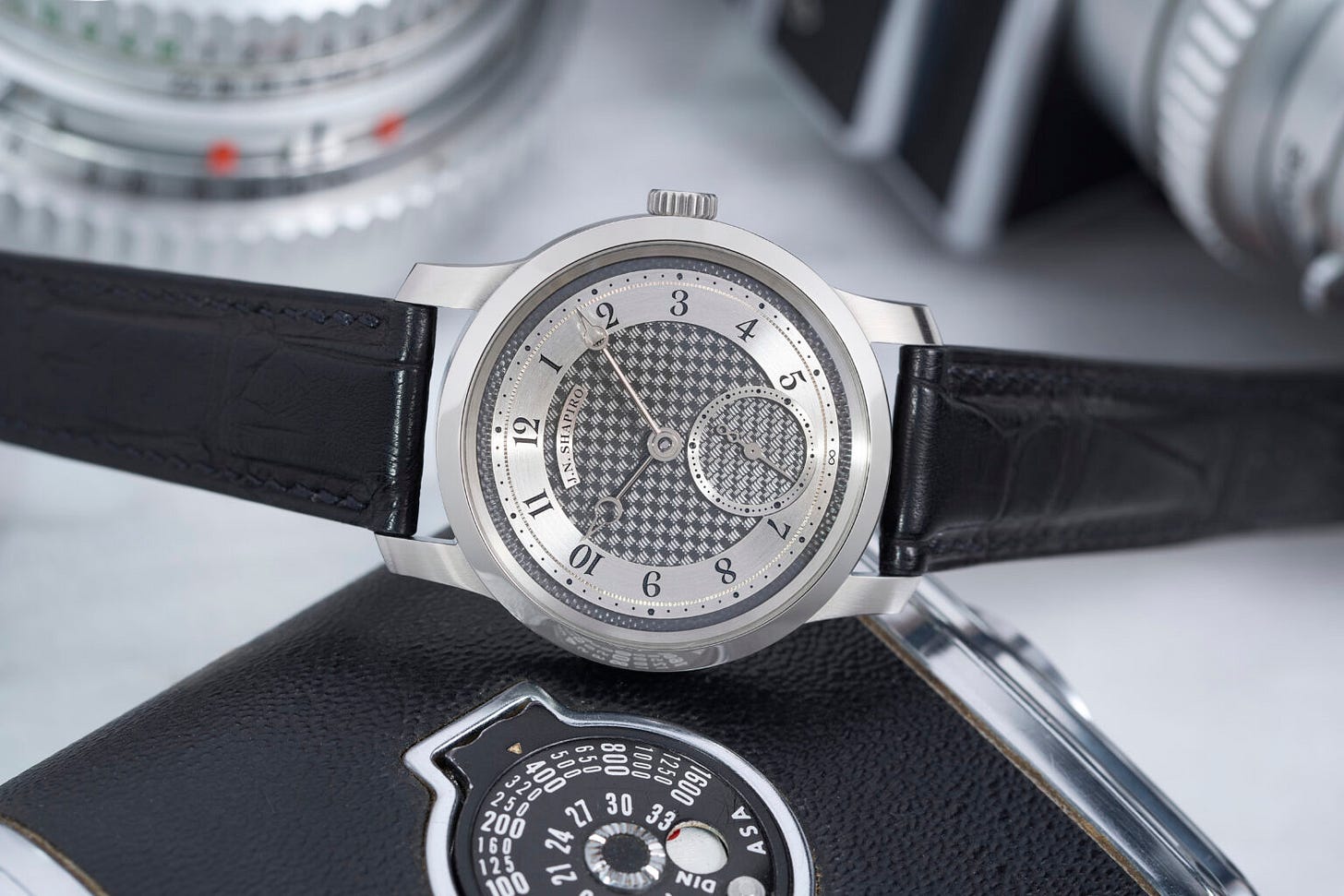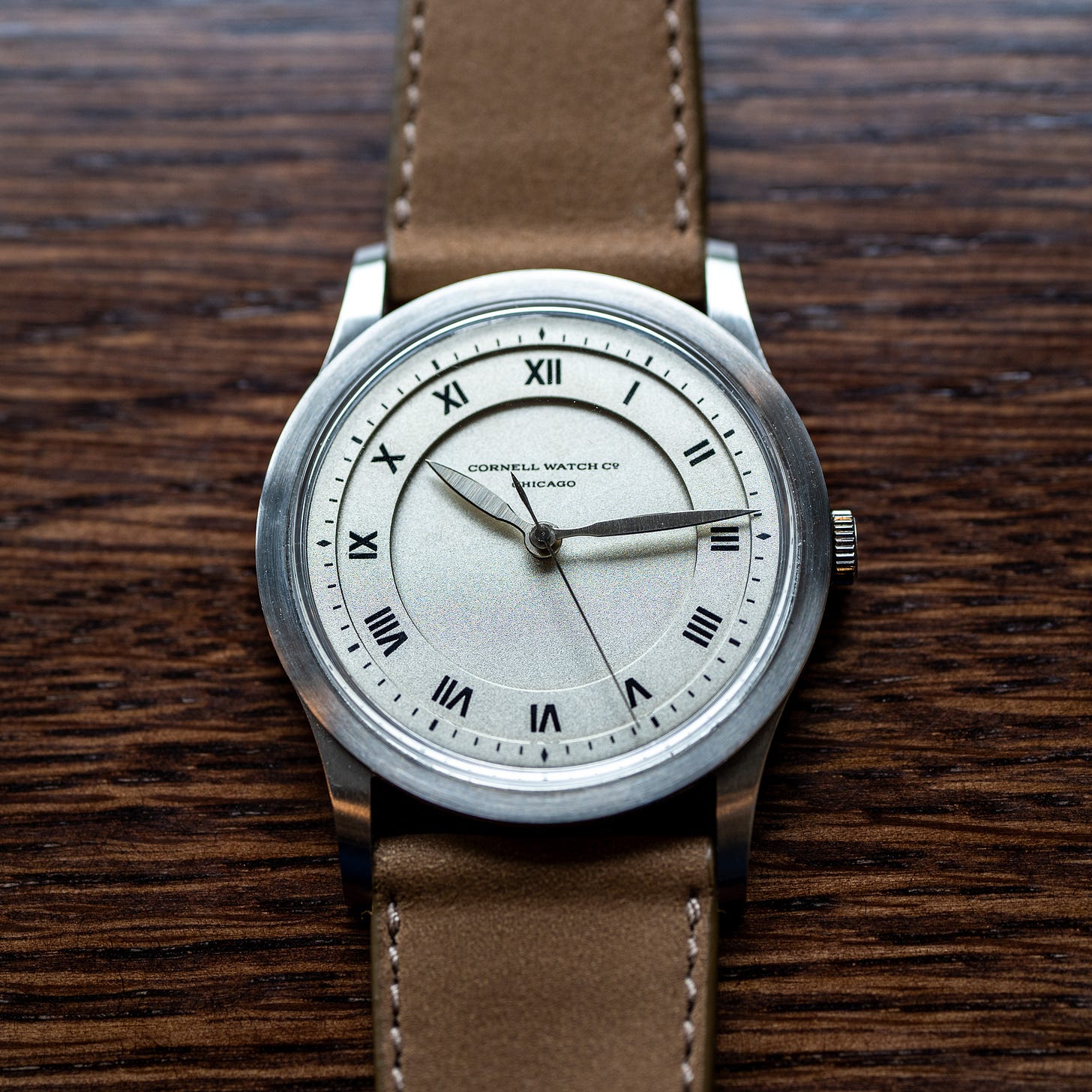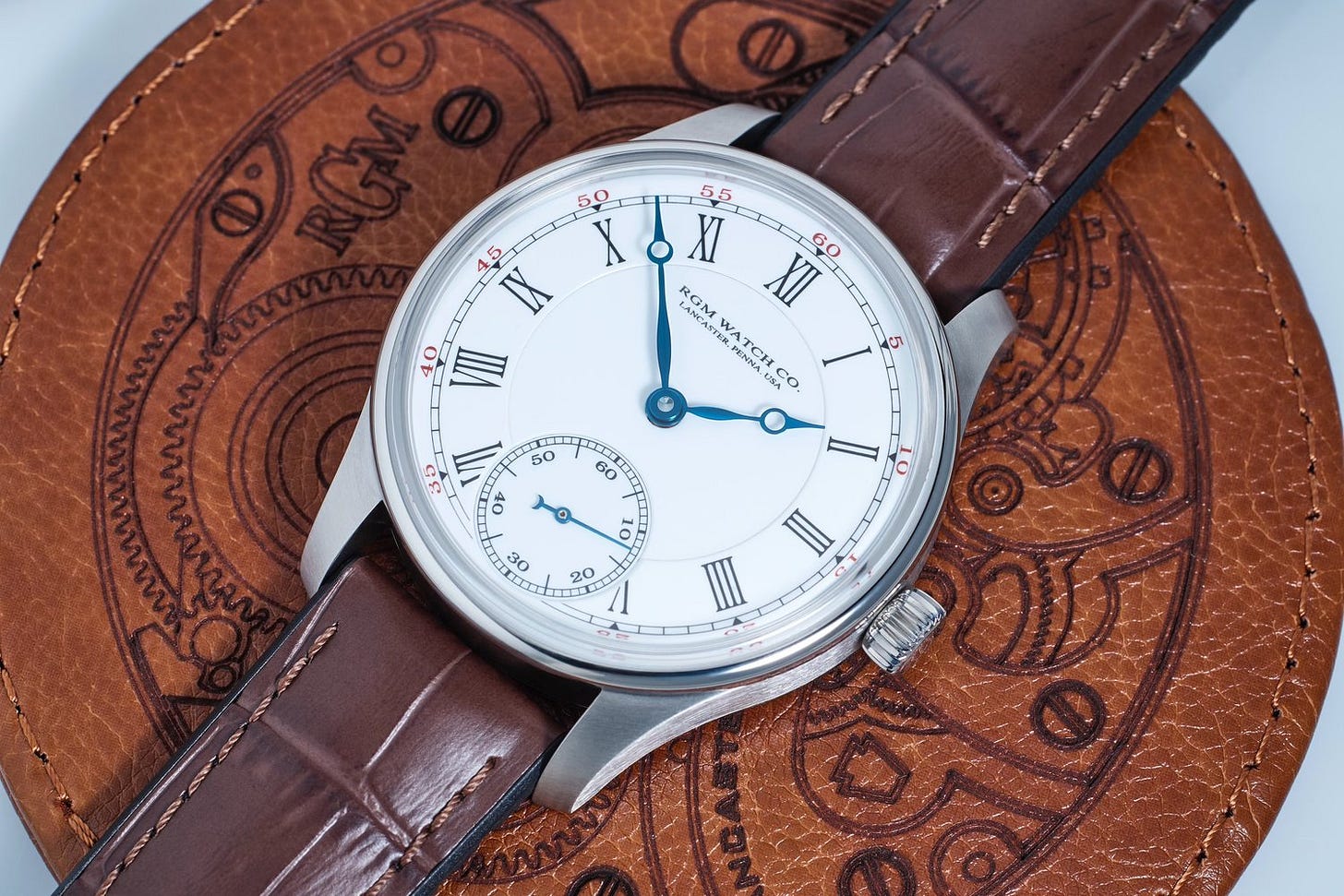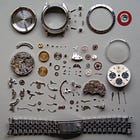Forget American, These Guys Just Wanna Make Great Watches
Inside the new wave of U.S. watchmaking—and why it’s not about waving the flag.
Last weekend, I organized a small watches & coffee meetup here in Chicago. A few local collectors, some good watches, and a couple cars showed up:
Thanks to my buddy Nino for hosting, who must have one of the coolest spaces in Chicago for get-togethers like this. Hanging out is one of the best things about watches, so hopefully we can do more of these in Chicago (or even take it on the road?). I’m helping to organize another event during Windup Chicago in a few weeks, so stay tuned for more info.
Forget American, These Guys Just Wanna Make Great Watches
Josh Shapiro and Zach Smith aren’t trying to sell you on patriotism. They just want to make great watches. But along the way, they’re reinventing watchmaking in the United States.
“It’s not ‘Made in the USA’ just for the sake of it,” Smith told me. “I’m doing it because I want to make quality watches.”
That’s the common thread between Smith, founder of Hour Precision, and Shapiro, the Los Angeles-based watchmaker behind J.N. Shapiro. Both are building out real manufacturing capabilities in the U.S., often from scratch. But they don’t want the conversation to stop at geography. They want to make watches that can stand next to the best of Switzerland, Germany, or Japan.
It just so happens they’re doing it in Torrance, California, and Columbus, Ohio.
Resurgence
In 2023, Shapiro released the Resurgence, a fully American-made watch starting at $70k, the culmination of work that began in 2015 when he made his first guilloche dials for watch and clock maker David Walter. It was a statement for Shapiro and his team. And now that it’s out, he’s turning the page.
“We don't need to flag-wave anymore,” Shapiro told me. “For our next watches, we just want the quality to speak for itself.”

That starts with the recently-released Infinity Series Pure ($26,000).
“We’re in the United States, but that doesn’t define our design language,” Shapiro said. “We’re just trying to make the highest quality watches we can.” For the Infinity Series Pure, that means:
Shapiro’s Infinity Weave pattern, basically a basketweave within a basketweave
The hands are sculpted (not stamped) and then hand-polished
Beyond that, it uses a Swiss La Joux-Perret movement and other outsourced components. It’s more accessible, but no less serious in intent.1
Meanwhile, Smith and Hour Precision are in the early days of manufacturing parts for other companies. He’s producing the case, dial, hands, and crown for the new Lozier from Cornell Watch Co. ($6,200). Here, too, the custom “Cornell Leaf” hands and three-tier dial made of German silver stand out.

It’s taken five years for Smith and Hour Precision to get here. He began from a sense of pragmatism, founding Hour Precision in 2019 when he needed a wheel to repair a vintage Jaeger-LeCoultre. JLC wouldn’t provide it, and no other restoration shops could make it, so Smith decided to try himself.
It’s grown from there.
Zach has experience machining for tech and aerospace, and knew he’d need higher production volumes to build a real business. To do that, he needed the fancy, high-end machines that help you make the exact same thing, over and over.
So he started acquiring KERN CNC machines, usually broken ones he’d fix up. One of the last machines he bought cost about $300k. Tooling those machines isn’t cheap either.
But perhaps the biggest problem: Finding the right talent.
“There’s often this understanding that you can draw something in CAD [computer-aided design], push a button, and out pops a case. But that’s not how it works.”
We’ll get back to that.
Behind the Label
The first hurdle to manufacturing in America versus Switzerland? The label alone.
As a reminder, here are the requirements for a watch to be Swiss Made:2
60% of manufacturing costs are incurred in Switzerland
Technical development must take place in Switzerland
Movement must be cased up in Switzerland
Final inspection must occur in Switzerland
The movement is Swiss, meaning:
It’s assembled, tested, and inspected in Switzerland
60% of manufacturing costs of the movement must be generated in Switzerland
This leaves plenty of room for global outsourcing—especially for cases, dials, or even movement components.
“The Swiss have a huge competitive advantage,” Shapiro said. “‘Made in Switzerland’ can basically mean made in China and QC’d in Switzerland.” This is not to sell short the watchmaking in Switzerland. It’s the heart of the industry, and where much of the value-add happens, especially at the high end.
“It's a testament to how good Chinese watchmaking is that the quality is indistinguishable from something made in Switzerland,” Shapiro said.
Meanwhile, the “Made in USA” standard is far stricter. According to the Federal Trade Commission (FTC), a product must be “all or virtually all made in the U.S.,” with no significant parts or processing abroad. When Shapiro announced the Resurgence, nearly every component was produced in-house or sourced from a domestic supplier.
It’s particularly difficult to meet the “Made in USA” requirements because there’s no network of watchmaking suppliers in the U.S. Instead, Shapiro, Smith, and a few others are building it from the ground up.
One example: Every steel component of a watch needs to be heat-treated. In Switzerland, one company is really good at it. But to develop the process for themselves, Shapiro said he spent six months and $100k on R&D.
The Limits of Patriotism
While important, I find these discussions about “Made In” can lead to purity tests that miss the larger point.
The more important question: Is it actually a good watch? As Zach put it:
“How many times is something made in the U.S., and that actually just means it’s an overpriced piece of sh*t? And I say this about myself—because what do Americans know about making watches?”
Zach is proud of what he’s built, but quick to acknowledge that making watches is an exercise in lifelong learning.
While Shapiro is leading the way for the rebirth of American watchmaking, he’s also pushing forward, and wants to go even further than the industry did in its heyday.
“We have a lot to learn in terms of complications,” Shapiro said. Historically, the U.S. industry wasn’t prolific in complications—the Swiss were able to move faster, while vertically-integrated U.S. manufacturers mostly stuck to high-grade railroad watches.
This pursuit of quality is more important than where it’s happening. For decades, Swiss marketing has trained consumers to associate “Swiss Made” with precision and quality. But instead of listening to the marketing, look at their actions. They outsource all over the world, wherever there’s capability and talent. An implicit acknowledgment that great watches can come from anywhere—Switzerland, Japan, China, the U.S.
“Swiss Made” isn’t strictly a statement of origin. It’s a brand, just like any other European heritage brand we buy into. Sometimes it’s worth it, sometimes not. It’s up to each collector to understand, critique, and decide what matters to us. Increasingly, there’s a sense of patronage among a certain type of collector who wants to understand who’s making their watch, and where.
The Talent Gap
Another uphill battle? Labor. Watchmaking education in the U.S. has changed dramatically. As I covered last year, traditional two-year programs like Lititz Watch Technicum have closed, while the remaining brand-funded schools increasingly emphasize training technicians.
“Brands want someone just qualified enough to switch out a movement and hands,” Shapiro said. “It's cheaper for them to replace movements than diagnose them.” Large brands want fast, efficient service in the U.S., while more complex projects or restorations can be sent to fully trained watchmakers in Switzerland.
Smith agrees: “These schools are just teaching students to change parts. You need experience behind the bench. Someone eventually has to bear that weight.”
For now, it falls to shops like J.N. Shapiro to fill the gap and teach skills to watchmakers, engineers, and machinists that aren’t taught in schools. Shapiro’s team is now more than 10 people, split between engineers, machinists, and watchmakers.
He said that if enough demand for American production grows, eventually a proper school will have to be started in the U.S., “otherwise it’s going to be incredibly difficult to progress.”
“We need complete watchmakers,” Shapiro said. “Someone who can use a lathe, and black polish, and vibrate a hairspring. Not just swap a movement.”
The Long Game
Despite these hurdles, both Smith and Shapiro are optimistic.
“It’s like the Wild West right now,” Smith said. “There’s room for multiple shops that can share work, just like in Glashütte [Germany].” That also helps spread costs and risk.
Shapiro and Smith aren’t alone. Colorado Watch Company produces cases, dials, and other components in Fort Collins, Colorado. On the other end of the spectrum, independent watchmaker Keaton Myrick makes 10-12 watches a year from his workshop in Bend, Oregon. Of course, RGM has been making watches in Pennsylvania for decades.
Shapiro sees his company as a “stigma breaker,” proving that American watchmaking can achieve the same levels of excellence as in Switzerland or Japan. The goal isn’t to take over, but to create a viable alternative.
Leading with Quality
For both watchmakers, the ideal future isn’t about draping the American flag over a watch dial. They want to build a real industry by leading with quality.
“Historically, America was good at mass producing high-quality products, whether it was pocket watches or Model Ts or airplanes,” Shapiro said. He’s focused on high quality first, hoping that higher production will follow.
No doubt: Prices are high for now. The upfront investment is steep, and being amortized across production that numbers in the hundreds.
But this slow-and-steady approach makes sense: Chip away at the production of cases, dials, or hands. Figure out where you can add value for consumers, and where other suppliers have it figured out. After all, it works for the Swiss.
But if these early efforts succeed, production can scale, and prices can come down.
I’ve heard both Smith and Shapiro mention six-figure investments with such matter-of-fact detachment that when they say they spent $100k on heat treating, you know there were similar costs for pad printing, case finishing, engraving crowns, or countless other processes.
Put simply: These guys aren’t getting rich making cheap watches and selling hype. They hire PR firms, but that’s about it. They’re pouring everything they can into the actual watches.3 Their cost structures are so different from legacy brands that it hardly makes sense to compare them.
Still, they’ll have to give consumers a reason to care. Patriotism only goes so far. Japanese watchmaking offers one model, with Seiko’s technical innovation (Spring Drive) and excellent finishing (Credor) offer an alternative to traditional Swiss watchmaking.
For some collectors, Shapiro is already doing this with his Infinity Weave and Damaskeening techniques (essentially the American version of Geneva Stripes).
But these things take time—generations, even.
While the focus is on quality, Shapiro is still a historian (he taught history before he started making dials). He’s well aware of the legacy of American watchmaking, and committed to building it back.
“Nobody wants to see a species go extinct,” he said. “We're used to the United States always being like the Goliath, but our watch industry was very much squashed by the Swiss.”
“It’s a shame it disappeared. And bringing it back is really, really important to me.”
You can’t change where you’re from.
Postscript: Tariffs
Rumbling along in the background of these conversations about American watchmaking and manufacturing is the political discourse about tariffs and making things great again.
Shapiro had this to say:
“American manufacturing didn’t disappear, it just got so good we don’t need such a huge workforce anymore. At the same time, our demand for manufacturing has multiplied. We consume more than ever before.”
Perhaps tariffs make sense in a vacuum. A 10% tariff on Swiss watches immediately makes American watches more competitive. But it’s not so simple. Even the most “American-made” watches have Swiss components. Not to mention the machines required (often from Switzerland).
Watchmaking is a global industry, and any effort to build in the States has to acknowledge that and leverage it where possible. Take Shapiro’s participation in the Alternative Horological Alliance, along with brands from Malaysia (Ming), U.K. (Fears), and those using global partners, often Swiss (Fleming and Massena).
Maybe it’ll result in watches that are proudly “Made in USA.” But for many of us, a high-quality watch will be more than enough.
I’m excited about Shapiro, Smith (and Cornell), and this generation of American watchmakers because they seem intent on defining a real American point of view on mechanical watchmaking. It’s not some overly-literal Americanism covered in flags and trains and bald eagles, but more rooted in wanting to make good, classically-inspired watches. Less about revival, and more about reinvention—driven not by nostalgia, but the desire to build something excellent from the ground up.
Further reading & listening:
Shapiro’s HSNY lecture on the birth, death, and rebirth of American watchmaking
Inside Hour Precision, Worn & Wound
Zach also developed a dual-time mechanism in collaboration with Typsim, featured here:
Shapiro also said the Infinity Series is more profitable, while the Resurgence is his “crazy passion project.”
Here’s the official Swiss ordinance if you really want to dig into it the requirements for “Swiss Made.”
Meanwhile, I’ve gotten about a dozen PR/marketing emails about some new Panerai that looks like an old Panerai that released this week. I know who’s investing more in the product!









The problem is that if you're competing in a global market for luxury, your value proposition can't be relative only to your costs of R&D and you can't say that your R&D and tooling up costs are being passed onto the consumer for a product that isn't competitive at its price point. You're competing in a global market and your value prop is going to be evaluated relative to the global market. I think lots of folks will understand and even want to underwrite startup and development costs, but as Lotus points out that doesn't scale. And appealing to folks to please understand that R&D and tooling up costs are high and that those costs are built into the price structure is totally understandable, but it's a subtler form of flag waving but flag waving nonetheless. I don't know what the solution is really.
consumers will pay for the product and they will pay for the brand.
when it comes to a $26k steel watch with a generic case and caliber, what is the consumer paying for? the brand.
is the shapiro brand strong enough to move the planned 36 pieces per year? it probably is.
what if it was a 100 pieces a year? highly unlikely.
a 1000 pieces? not a chance.